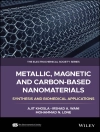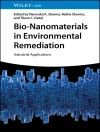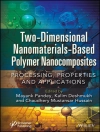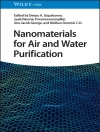Wie man den Transport von Ladungsträgern und Excitonen in molekularen Drähten steuert, beschreibt dieser in sich geschlossene, gut verständlich geschriebene Band. Dabei kommen Charakterisierungsverfahren (Spektroskopie), neueste Messergebisse, Verfahren zur Optimierung von Bauelementen und quantitative Modelle gleichermaßen gründlich zur Sprache. Zusätzlich finden Sie einen Überblick über Synthesemethoden zur Herstellung verschiedener Typen von organischen Drähten. Für Chemiker, Molekülphysiker, Materialwissenschaftler und Elektrotechniker.
Innehållsförteckning
INTRODUCTION: MOLECULAR ELECTRONICS AND MOLECULAR WIRES
Introduction
Single-Molecule Devices
Transport of Charges and Excitons in Molecular Wires
PART I: Molecules between Electrodes
QUANTUM INTERFERENCE IN ACYCLIC MOLECULES
Introduction
Theoretical Methods
Interference in Acyclic Cross-Conjugated Molecules
Understanding Interference in Model Systems
Using Interference for Devices
Probing the Limits of Calculations: Important Real-World Phenomena
Conclusions
HOPPING TRANSPORT IN LONG CONJUGATED MOLECULAR WIRES CONNECTED TO METALS
Introduction
Charge Transport Mechanisms
Oligophenylene Imine Molecular Wires: A Flexible System for Examining the Physical Organic Chemistry of Hopping Conduction in Molecules
Outlook: Probing the Physical Organic Chemistry of Hopping Conduction
PART II: Donor-Bridge-Acceptor Systems
TUNNELING THROUGH CONJUGATED BRIDGES IN DESIGNED DONOR-BRIDGE-ACCEPTOR MOLECULES
Introduction
Through-Bond Electronic Coupling in Pi-Conjugated Bridges
Conclusions
BASE PAIR SEQUENCE AND HOLE TRANSFER THROUGH DNA: RATIONAL DESIGN OF MOLECULAR WIRES
Introduction
Spectral Signatures of Charge Transfer
Charge Injection into A-Tracts
Crossover from Superexchange to Hopping in Sa–An–Sd
Symmetry Breaking in Sa–An–Sa
Influence of a Single G on Charge Transport
Molecular Wire Behavior in Sa–A2-3G1-7–SD
Charge Transfer through Alternating Sequences
Theoretical Descriptions of Charge Transfer through DNA
Conclusion
CHARGE TRANSPORT THROUGH MOLECULES: ORGANIC NANOCABLES FOR MOLECULAR ELECTRONICS
Introduction
Theoretical Concepts
Charge Transport along Pi-Conjugated Bridges in C60-Containing Donor-Bridge-Acceptor Conjugates
Conclusion
PART III: Charge Transport through Wires in Solution
ELECTRON AND EXCITON TRANSPORT TO APPENDED TRAPS
Introduction
Experimental Methods to Investigate Transport to Appended Traps
Results on Transport to Traps
Comparison and Perspectives
ELECTRON LATTICE DYNAMICS AS A METHOD TO STUDY CHARGE TRANSPORT IN CONJUGATED POLYMERS
Introduction
Methodology
Results
Summary
CHARGE TRANSPORT ALONG ISOLATED CONJUGATED MOLECULAR WIRES MEASURED BY PULSE RADIOLYSIS TIME-RESOLVED MICROWAVE CONDUCTIVITY
Introduction
Pulse-Radiolysis Time-Resolved Microwave Conductivity
Mechanisms for Charge Transport along Conjugated Chains
The Meaning of the Mobility at Microwave Frequencies
Charge Transport along Ladder-Type PPP
Effect of Torsional Disorder on the Mobility
Effect of Chain Coiling on the Mobility of Charges
Supramolecular Control of Charge Transport along Molecular Wires
Summary and Outlook
PART IV: Exciton Transport through Conjugated Molecular Wires
STRUCTURE PROPERTY RELATIONSHIPS FOR EXCITON TRANSFER IN CONJUGATED POLYMERS
Introduction
Signal Gain in Aplifying Fluorescent Polymers
Directing Energy Transfer within CPs: Dimensionality and Molecular Design
Lifetime Modulation
Conformational Dependence on Energy Migration: Conjugated Polymer-Liquid Crystal Solutions
Conclusions
Om författaren
Laurens Siebbeles studied chemistry at the Free University in Amsterdam and obtained his Ph D degree at the FOMInstitute for Atomic and Molecular Physics in Amsterdam. He was a post-doc at the University of Paris Sud in France. Currently he is Professor in opto-electronic materials at the Delft University of Technology in The Netherlands. He studies the dynamics of charges and excitons in molecular materials and semiconductor nanocrystals. Charges and excitons are produced with high-energy electron or laser pulses and probed by time-resolved optical and microwave or terahertz measurements. The experiments are supported by theory of charge and exciton dynamics.
Ferdinand Grozema studied chemistry at the University of Groningen and obtained his Ph D degree at the Delft University of Technology. In 2007 he spent 7 months working as a visiting scholar at Northwestern University in Evanston, USA. Currently he is an Assistant Professor in the opto-electronic materials section at the Chemical Engineering Department of the Delft University of Technology in Delft. His research
interests consist of theoretical and experimental studies of the properties and dynamics of excited states in bio/organic materials. The main focus of this research has been on charge transport in conjugated molecular wires and in DNA.












